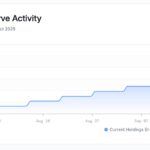The world of cryptocurrency is witnessing another wave of volatility as Aave’s governance token, AAVE, encounters significant selling pressure. In the past 24 hours, the price of AAVE dipped below the $270 mark, reflecting a stark 5% decline in the early hours of Thursday and a nearly 10% drop from its peak earlier in the week.
This downturn is part of a broader weakening trend across the cryptocurrency market, highlighted by Bitcoin inching towards a critical threshold below $120,000. The CoinDesk 20 Index, which tracks a diverse range of cryptocurrencies, reported a more than 4% drop during this challenging trading session. Analysts suggest that the technical landscape looks bearish for AAVE, with the recent loss of support around $273 triggering a cascade of selling.
“The spike in trading volume, exceeding 63,651 units, indicates heightened market activity as traders reacted to the falling prices,” according to CoinDesk Research’s analysis.
As the price briefly recovered to around $272, attempts to regain higher ground faced tough resistance, particularly around the $280 level. However, continued failure to hold key support levels has raised concerns about further selling pressure, emphasizing the current uncertainty in the decentralized finance (DeFi) sector.

Aave (AAVE) Selling Pressure and Market Impact
Key points regarding the recent volatility of Aave’s governance token:
- Significant Price Decline: AAVE dipped below the $270 level, with a 5% plunge in early trading.
- Market Context: Broader cryptocurrency market weakens, with bitcoin nearing a critical support level of $120,000.
- Technical Analysis: Bearish momentum indicated by CoinDesk Research’s model, suggesting ongoing selling pressure.
- Support Levels: The loss of support at $273 led to increased selling, with trading volume spiking significantly.
- Failed Recovery Attempts: Subsequent attempts to recover have not succeeded, highlighting a challenging market environment.
- Resistance Level: Technical resistance established at the $280 mark complicating future recovery efforts.
Understanding these dynamics is crucial for investors in navigating the fluctuating DeFi landscape and making informed decisions.
Aave (AAVE) Faces Significant Selling Pressure Amid Broader Crypto Market Decline
The recent downturn in Aave’s governance token value highlights a challenging phase for decentralized finance (DeFi) platforms. A 5% decline in a single trading session, alongside a steep 10% drop from earlier weekly highs, underscores vulnerabilities faced by DeFi giants like Aave compared to competitors in the space. A noteworthy contrast can be found in established protocols like Compound, which, despite similar market conditions, have managed to maintain their value better due to more resilient governance structures and community engagement methodologies.
Competitive Advantages: Aave has a robust user framework and an engaged community, which could serve as a foundation for recovery. Its unique lending features, such as flash loans, offer advantages that set it apart from conventional lending platforms. However, with the descent below the $273 support level, Aave now faces technical setbacks that may hinder its immediate recovery trajectory. The high trading volumes witnessed might indicate increased interest or opportunistic buying, which could stabilize the price in the short term.
Competitive Disadvantages: Aave’s struggle during a broader market downturn highlights potential weaknesses in market sentiment and user confidence, unlike Compound, which has benefitted from a more stable growth trajectory. The abrupt price drop and failed recovery attempts signal overexposure to market volatility, which could deter new investors. Additionally, algorithmic selling triggered by key support losses raises concerns regarding systemic vulnerabilities inherent to DeFi platforms.
This situation can benefit seasoned traders and opportunistic investors looking for low-entry points amidst a decline. However, it poses challenges for retail investors who may be drawn to the narrative of a quick recovery only to find themselves in deeper losses if momentum does not shift. Thus, the current market dynamics create a complex environment, where potential gains are intricately balanced against the looming risks associated with a volatile DeFi space.

















